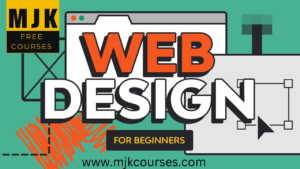
Web Designing – Web Designing Course Online
Table of Contents
ToggleWeb Designing: A Complete Guide for Beginners
In today’s digital era, having an online presence is essential for any business or individual. A website is the backbone of online presence, and web designing is the process of creating and maintaining a website. Web designing involves several elements, including website layout, color scheme, graphics, typography, and user experience.
In this article, we’ll provide a complete guide for beginners to understand web designing, its importance, and best practices to create a visually appealing and functional website.
Why is Web Designing Important?
A well-designed website helps to build trust with the audience, increases engagement, and encourages users to stay longer on the site. Moreover, it helps to establish a brand identity and creates a positive perception of the business. A poorly designed website, on the other hand, can negatively impact the user experience, lead to a high bounce rate, and damage the brand’s reputation.
Best Practices for Web Designing
- Responsive Design: With the increasing use of mobile devices, having a responsive website design has become essential. Responsive design ensures that the website layout adjusts automatically to the screen size of the device, providing a seamless user experience.
- Simple Navigation: Navigation is an essential element of web designing, and a simple and intuitive navigation system helps users to find the information they are looking for easily.
- Visual Hierarchy: Visual hierarchy refers to the arrangement of website elements in a way that guides the user’s attention toward the most important content. Using different font sizes, colors, and visual elements can help to create a clear visual hierarchy.
- Consistent Branding: Consistency in branding elements such as color scheme, typography, and logo can help to establish a strong brand identity and create a memorable user experience.
- Fast Loading Speed: Website loading speed is a critical factor in user experience and can impact the website’s search engine ranking. Optimizing images, using a content delivery network (CDN), and minimizing HTTP requests are some ways to improve website loading speed.
- Accessibility: Web designing should consider accessibility for users with disabilities. Adding alt tags to images, using readable fonts, and providing keyboard navigation are some ways to make the website more accessible.
- Content Strategy: A well-planned content strategy ensures that the website’s content is relevant, engaging, and informative. Content should be structured using headings, subheadings, and bullet points to make it easy to read.
Web Designing Process
The web designing process involves several steps, including:
- Understanding the Project Requirements: The web designing process starts by understanding the project requirements, such as the target audience, website goals, and content.
- Planning: The planning stage involves creating a sitemap and wireframes, which provide a visual representation of the website’s layout and content structure.
- Design: The design stage involves creating the website layout, color scheme, and visual elements. It’s essential to consider the brand identity, target audience, and user experience while designing the website.
- Development: The development stage involves coding the website using HTML, CSS, and JavaScript. The website’s functionality and interactivity are tested during this stage.
- Testing and Launch: The website is tested for bugs, usability, and performance before launch. Once the website is ready, it’s launched on the hosting server.
Conclusion
Web designing is a critical aspect of creating a website that provides a positive user experience and establishes a strong brand identity. By following the best practices of web designing and understanding the web designing process, beginners can create a visually appealing and functional website. It’s essential to prioritize user experience, website loading speed, and accessibility while designing a website to ensure that it’s search engine optimized and outranks other websites.

How To Earn From Web Designing
Web designing is a skill that can be monetized in several ways. As a web designer, you can earn by providing web design services to clients, selling website templates, or starting a web design agency.
Offering Web Design Services
One of the most common ways to earn from web designing is by offering web design services to clients. By showcasing your web designing skills through a portfolio website or social media, you can attract potential clients who are looking for a professional website.
To optimize your website for search engines, make sure to include the keyword “web designing” in the title tags, meta descriptions, and content. This will help your website rank higher in search results and increase visibility to potential clients.
You can charge clients based on the complexity of the project, the number of web pages, and the level of customization required. It’s important to communicate clearly with the client about the project requirements and scope of work to avoid any misunderstandings and ensure a successful project.
Selling Website Templates
Another way to earn from web designing is by creating and selling website templates. This option is suitable for web designers who have a good eye for design and coding skills. By creating templates for different types of websites, such as e-commerce, blogs, or portfolios, you can sell them on marketplaces like ThemeForest or Creative Market.
To optimize your website template for search engines, make sure to include the keyword “web designing” in the template’s title, description, and tags. This will help your template rank higher in search results and increase its visibility to potential buyers.
Starting a Web Design Agency
If you have more experience in web designing and want to take on larger projects, starting a web design agency might be the way to go. You can hire a team of designers and developers to work on multiple projects simultaneously, increasing your earning potential.
To optimize your agency’s website for search engines, make sure to include the keyword “web designing” in the title tags, meta descriptions, and content. Additionally, you can create a blog section on your website and publish articles related to web designing, which can help establish your agency’s authority and improve your search engine ranking.
Conclusion
Web designing is a skill that can be monetized in several ways, including offering web design services, selling website templates, or starting a web design agency. To optimize your online presence for search engines, it’s important to include the keyword “web designing” in the website’s content and meta tags. By following best practices in web designing and providing high-quality services to clients, you can build a successful career in web designing and increase your earning potential.
Here are some additional headings that can be included:
- Understanding the Basics of Web Designing
- Building a Strong Portfolio for Web Designing Services
- Developing a Niche for Your Web Designing Services
- Marketing Your Web Designing Services Online
- Creating and Selling Web Templates: A Lucrative Side Hustle
- The Pros and Cons of Starting a Web Design Agency
- A Team of Designers and Developers: Recruiting and Managing
- Scaling Your Web Design Agency: Challenges and Opportunities
- Staying Up-to-Date with the Latest Trends and Technologies in Web Designing
- Conclusion: Unlocking Your Potential as a Web Designer.
By including these additional headings, we can provide more detailed and targeted information about various aspects of web designing and how to monetize this skill in the most effective way. It also helps to break down the content into easily digestible sections, making it more engaging and appealing to readers.

Explanation of each Heading:
Understanding the Basics of Web Designing:
- Before you can start earning from web designing, it’s important to understand the basic concepts of web design, including the principles of design, color theory, typography, and layout. You should also be familiar with popular web design tools such as Adobe Photoshop, Sketch, and Figma, as well as front-end programming languages such as HTML, CSS, and JavaScript.
Building a Strong Portfolio for Web Designing Services:
- Creating a strong portfolio is essential for attracting potential clients to your web design services. Your portfolio should showcase your best work, highlight your skills and expertise, and demonstrate your ability to design websites that meet your clients’ needs.
Developing a Niche for Your Web Designing Services:
- To stand out from the competition, you can develop a niche for your web designing services. This could be specializing in designing websites for a particular industry, such as e-commerce or healthcare, or offering a unique design style, such as minimalist or retro.
Marketing Your Web Designing Services Online:
- Marketing your web designing services online can help you attract more clients and increase your earning potential. You can use social media, email marketing, and online advertising to promote your services to a wider audience.
Creating and Selling Web Templates: A Lucrative Side Hustle:
- If you have a talent for designing website templates, you can earn a passive income by selling them on online marketplaces like ThemeForest or Creative Market. This can be a great way to monetize your skills while continuing to offer web designing services to clients.
The Pros and Cons of Starting a Web Design Agency:
- Starting a web design agency can offer many advantages, such as the ability to take on larger projects and work with a team of designers and developers. However, it also comes with challenges such as managing finances, hiring and training staff, and dealing with client expectations.
Hiring and Managing a Team of Designers and Developers:
- If you decide to start a web design agency, you will need to hire and manage a team of designers and developers. This includes creating job descriptions, interviewing candidates, and providing ongoing training and support to your team.
Scaling Your Web Design Agency: Challenges and Opportunities:
- Scaling your web design agency can present new opportunities for growth and increased revenue, but it also comes with challenges such as maintaining quality control, managing project timelines, and balancing workload.
Staying Up-to-Date with the Latest Trends and Technologies in Web Designing:
- As a web designer, it’s important to stay up-to-date with the latest trends and technologies in web designing, such as responsive design, mobile-first design, and the use of CSS frameworks. This will help you offer the latest and most innovative design solutions to your clients.
Conclusion: Unlocking Your Potential as a Web Designer:
- By combining your creativity, technical skills, and business acumen, you can unlock your full potential as a web designer and build a successful career in this field. Whether you choose to offer web designing services, sell website templates, or start a web design agency, the key is to provide high-quality services, stay up-to-date with the latest trends, and keep learning and growing as a professional.

Graphic Designing Course
Desired Outcome:
By the end of this course, learners will be able to create professional-level graphic designs using industry-standard software and tools. They will be able to apply design principles, color theory, and typography to create effective visual communication.
Project Plan:
Learners will design a promotional campaign for a local business, which includes a logo, business card, and social media posts.
Module 1: Introduction to Graphic Design
Lesson Plan:
- Learning Objectives: To understand the basic concepts of graphic design, including visual elements, principles of design, and color theory.
- Real-World Examples: Show examples of effective graphic designs used in advertising, social media, and packaging.
- Activities: Create a mood board to showcase the elements of design that appeal to the learner.
Module 2: Design Software and Tools
Lesson Plan:
- Learning Objectives: To become familiar with the use of design software and tools, including Adobe Photoshop and Illustrator.
- Real-World Examples: Demonstrate the use of design software to create logos, business cards, and social media posts.
- Activities: Design a simple logo using Adobe Illustrator, and create a business card in Adobe Photoshop.
Module 3: Typography and Color Theory
Lesson Plan:
- Learning Objectives: To understand the importance of typography and color in graphic design, and how they contribute to visual communication.
- Real-World Examples: Show how different fonts and colors can convey different messages and moods.
- Activities: Create a color palette and use it to design social media posts for the promotional campaign.
Module 4: Design Principles
Lesson Plan:
- Learning Objectives: To apply design principles to create effective graphic designs.
- Real-World Examples: Show how layout, hierarchy, and balance can be used to create visually appealing designs.
- Activities: Create a mockup of the business card and social media posts using design principles.
Module 5: Final Project Part 1 – Logo and Business Card
Lesson Plan:
- Learning Objectives: To apply all the skills learned in the previous modules to design a logo and business card for the promotional campaign.
- Real-World Examples: Show how logos and business cards are used in branding and marketing.
- Activities: Design a logo and business card for the local business.
Module 6: Final Project Part 2 – Social Media Posts
Lesson Plan:
- Learning Objectives: To apply all the skills learned in the previous modules to design effective social media posts for the promotional campaign.
- Real-World Examples: Show how social media posts can be used to promote products and services.
- Activities: Design social media posts for the promotional campaign, using the logo and color palette.

Discussion Questions:
- How can design principles be used to create effective visual communication?
- What are some common mistakes to avoid when designing graphic materials?
- How can design be used to create a consistent brand image across different platforms?
Ways to Expand Learning:
- Invite a guest speaker from the design industry to talk about their experiences and insights.
- Explore the history of graphic design and its evolution over time.
- Have learners critique each other’s designs and provide feedback for improvement.
Engaging Video Script for Lesson 1:
“Welcome to module one of our graphic designing course! In this module, we will explore the basic concepts of graphic design, including visual elements, principles of design, and color theory. We’ll also look at real-world examples of effective graphic designs used in advertising, social media, and packaging. By the end of this module, you’ll be able to create a mood board to showcase the elements of design that appeal to you. This will be the foundation for creating your own graphic designs in the later modules. So let’s get started!”
Engaging Video Script for Lesson 2:
Welcome to the second module of our course on graphic designing! In this module, we will explore design software and tools, including Adobe Photoshop and Illustrator. We’ll also look at real-world examples of logos, business cards, and social media posts created using design software. By the end of this module, you’ll be able to design a simple logo using Adobe Illustrator and create a business card in Adobe Photoshop. So let’s dive into the world of design software and tools!”
Lesson 3: Typography and Color Theory Video Script:
“Welcome to the third module of our graphic designing course!” In this module, we will explore the importance of typography and color in graphic design, and how they contribute to visual communication. We’ll show you how different fonts and colors can convey different messages and moods. By the end of this module, you’ll be able to create a color palette and use it to design social media posts for the promotional campaign. So let’s explore the fascinating world of typography and color theory!”
Lesson 4: Design Principles Video Script:
“Welcome to module four of our graphic designing course! In this module, we will explore how to apply design principles to create effective graphic designs. We’ll show you how layout, hierarchy, and balance can be used to create visually appealing designs. By the end of this module, you’ll be able to create a mockup of the business card and social media posts using design principles. So let’s discover the secrets of effective design principles!”
Lesson 5: Final Project Part 1 – Logo and Business Card Video Script:
“Welcome to module five of our graphic designing course! In this module, we will apply all the skills learned in the previous modules to design a logo and business card for the promotional campaign. We’ll show you real-world examples of logos and business cards used in branding and marketing. By the end of this module, you’ll be able to design a logo and business card for the local business. So let’s get started on creating a professional logo and business card!”
Lesson 6: Final Project Part 2 – Social Media Posts Video Script:
“Welcome to the final module of our graphic designing course! In this module, we will apply all the skills learned in the previous modules to design effective social media posts for the promotional campaign. We’ll show you how social media posts can be used to promote products and services. By the end of this module, you’ll be able to design social media posts for the promotional campaign, using the logo and color palette. So let’s create some eye-catching social media posts to promote our local business!”
Project Plan Components:
- Logo design using Adobe Illustrator
- Business card design using Adobe Photoshop
- Social media post design using the logo and color palette
- Real-world examples of effective graphic designs used in branding and marketing
- Mockup creation of the business card and social media posts using design principles
Overall, this course aims to equip learners with the necessary skills to create professional-level graphic designs using industry-standard software and tools. By starting with the outcome in mind and working backward, learners will engage in project-based learning to apply design principles, color theory, and typography to create effective visual communication for a real-world application.
ACCESS TO THE PAID COURSE FOR FREE


